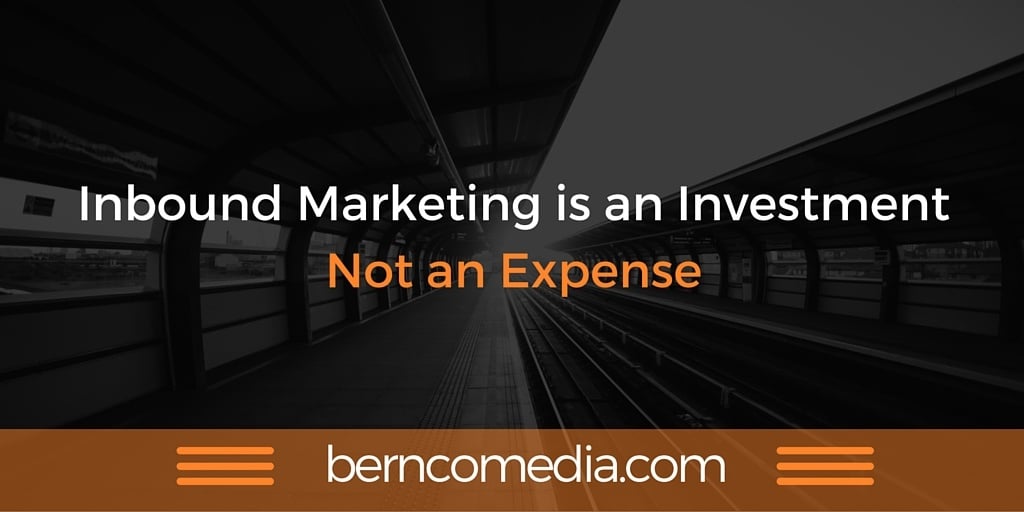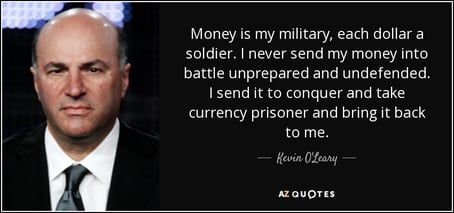Inbound Marketing is an Investment - Not an Expense
September 28th, 2015 | 4 min read

Are You Taking Chances With Your Marketing Dollars?
I speak with many business owners every week, and as we start talking about Inbound Marketing, often the response is along the lines of “I can’t afford that expense right now”.
For many businesses, small or large, marketing is often bundled into the expense category. And sure, on a P&L it is an expense, but I always tell them that Inbound Marketing is more of an investment in their business that will provide a return over time.
Now, when it comes to inbound marketing compared to other types of marketing, I'd say that other types can absolutely be an expense. And often, they are costly. So, what’s the difference?
Ability to track your marketing spend
I always ask my prospects about all of the marketing activities they are doing, and as we dig into it, I follow up by asking how it's working for them.
If they are doing print or other offline: I ask how they track. Most of the time, they are not tracking anything. Maybe they have a trackable phone number, or they ask customers how they heard of them. I'm also told that they “have to advertise in print for branding", or because their competition is doing it. No matter what, the majority of traditional advertising is not able to be tracked. Therefore, it’s vanity. It’s an expense.
If they are doing online marketing: I get access to their analytics, discuss how they are spending money online, and I can honestly say that at least 90% of the businesses I speak with:
- Do not understand the analytic reports
- Are not calculating conversions or ROI
- Have no real attainable goals
This my friends is an expense.
I was speaking to a prospect recently that was spending over $40K a month in Google AdWords, paid social media, as well as retargeting efforts.
- Nowhere were they tracking the results
- Nowhere were they tracking the ROI.
- Nowhere were they tracking the effectiveness of the campaign. Hell, there was no campaign!
- Nowhere were they tracking the cost of customer acquisition
The budget was the budget, and it was either on or off. All they knew was when the ads were running, they got sales. What if they could get the same results for a third of the cost, or what if they could increase sales by 300% with the same budget? If they keep doing what they are doing, unfortunately, they will never know, and may as well burn their cash in a fireplace.
What can not be tracked, or improved upon, is a wild ass guess. While you may be getting some sort of bump in business, it is almost certainly a guarantee that there is a lot of waste in your spending.
When working within the inbound marketing methodology, and using the best tools possible, you track everything. EVERYTHING. But, before you track, you plan. You come up with a strategy based on real-world data, based on your target market and personas, and over time, you become a smarter marketer.
Becoming a smarter marketer
Are your current, traditional marketing activities, helping you to become a better and smarter marketer? Yes, I know you own a business that sells widgets, and you are busy selling them, but seriously my friend, you are a marketer now.
Any money that you expense on marketing you better damn well be able to not only track, but take the data you receive and figure out what worked, and what didn’t, pivot when needed, and understand your customers better than anyone else.
Years ago in my family fireplace business, I was lucky enough to participate and then run our own RCI (rapid continuous improvement) events, also known as Kaizen. This process has you look at everything you do in your business, every process, every action, every step, every result, and you determine if there is a better way to do something. A way that will help you reduce time and costs, and increase productivity and the bottom line.
The same techniques can be applied to your website with inbound marketing. Measure everything, see what works, improve where needed, and start the process again.
Reduce costs or increase revenue?
As I discussed RCI/Kaizen above, think about how these activities can help you eventually reduce costs in your marketing department or other areas of your business. Could developing the internal processes, training, and execution eventually make you more efficient? Could it help you launch a website redesign or marketing campaigns faster, and/or more often? You bet. That example is both a cost reduction as well as an increase in revenue.
Another example:
Inbound content that is educational, and targeted to your ideal customer, will eventually help you create a more educated prospect, who is ready to buy, not reluctant to be sold. You will decrease your time in your sales process, and close more deals easily. Creating content that matches the stages of where your prospect is at in their buyer's journey is paramount to help reduce costs and increase sales.
Return on investment
You are your own bank now. You make the rules on your percentage of ROI!
Just like a bank, or investing in stocks, inbound marketing, when strategized and executed properly, will give you a return on your investment. How quickly and how much depends on many factors, but over time you will see the return.
I love this quote from Kevin O'Leary. While the quote refers to investing in a business, the same can be said about the money you invest in marketing properly.

Blogging, eBooks, white papers, webinars, social media, conversion optimization, PPC, SEO, podcasts, and live streaming, among other things, takes time to get rolling. But for every dollar you invest, as long as you stay the course, you should see a return in total revenue, as well as decreased costs in other departments.
Now, can you do some of the tactics above and not do “inbound marketing” and still have success? Maybe yes, maybe no. I guess it depends on what your definition of success is. Using the inbound marketing methodology forces you to think things through, and plan for the results you want, and keep you on the path to success.
Marketing your business properly, through inbound marketing, should be your religion. Period.
Let’s wrap this up
All of the above is assuming that you have a marketable product, something someone will want, or you will teach why they want it. If you have a bad product or provide a bad customer experience, there are not a lot of things you can do to get your return on investment back.
I hope I was able to make clear here the difference between expense vs investment when it comes to inbound marketing vs traditional or un-tracked marketing. Otherwise known as wasting your money.
There is obviously so much more to this story than I have time to write here, but basically, inbound marketing is like farming. The better your soil, the more you plant seeds, the more your water and fertilize, the better your harvest will be. While some may just plant that tomato plant in the backyard for fun, the serious farmers of the world have a system that they follow, and they know the results they will get.
The same goes for inbound marketing. Invest in proper marketing techniques for your business, and you will reap the rewards for years to come.
Until next time,
Doc
Owner/Head Coach @ Bernco Media. Digital sales & marketing since 1997. Passion for teaching companies to be the most trusted voice in their space. They Ask, You Answer Certified Coach & HubSpot Certified Partner & Trainer. Reversed Type 2 Diabetes doing KETO. Wears Mickey Mouse Daily. Daydreaming of next Disneyland Trip.
Topics: